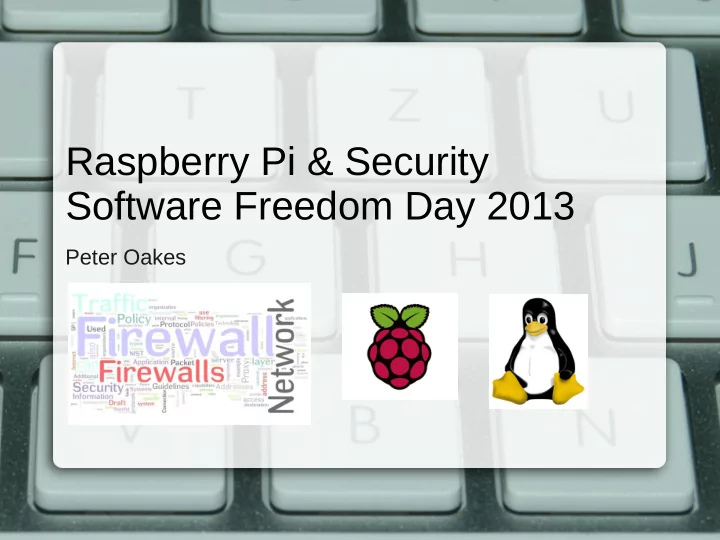

Raspberry Pi & Security Software Freedom Day 2013 Peter Oakes
IT/Cyber Security ● What is it? – Covers everything from 'physical' to user interactions ● Why care? – IT provides assets/resources – We depend on these resources – Store our information (confidential) – Control our information (integrity) – Provide information (availability)
Security = Easy ● Kind of... – Lots of terms and technologies, Firewall, port, encryption, RSA etc ● Back to basics – Think about we want to secure – Understand how security is configured – Similar to securing a house..
Raspberry Pi ● Aim to monitor and report security threats – Protecting and securing the device ● Out of the box install is insecure – Requires user to configure (harden) ● Electronics provide enhancements – Alerting/notification
Hack Yourself Need to understand what needs securing ● 'Discovery' exercise ● Who, what is on your network – Types of traffic – What ports are available – Incorrect configurations, out of date software – Several utilities ● Kali (Linux distribution 300+ tools) – Command line utilities – Web based (www.grc.com) –
Example Usage Kali ● Netdiscover – Zenmap – Nmap – Intrace – Tcpflow –
Securing The House Secure the house ● Fit doors – Add locks – Secure Windows....Not the Microsoft – type Establish secure entry i.e. letterbox – Hide away valuables – Fit alarms and video camera – ... Have a guard dog or hire a bouncer – Result ● Allows communication (letters) – Protects assets – Monitors and alerts owner –
Securing The Pi ● Lock our doors – IP Tables installed ● Monitor for suspicious behaviour – Log events – This is our video camera... ● Alert – Analyse events – Report events – This is our alarm/guard dog
IP Tables ● Its a rule-based firewall ● By default no rules defined ● To block an IP /sbin/iptables -I INPUT -s 192.168.0.5 -j DROP – DANGER: You can lock yourself out – ● To accept an IP /sbin/iptables -I INPUT -s 192.168.0.5 -j ACCEPT – ● To view the rules /sbin/iptables -L –
Logging ● By default most messages are recorded in: /var/log/messages – ● View it in real-time Tail -f /var/log/messages – ● Try it Logger “hello SFD 2013” – ● Very important resource ● Used for audit/diagnosing problems ● Other applications depend on these logs
Port Scan Attack Detector ● Software to report on attacks ● Monitors log events ● Has own rules ● View status: Psad -S – ● Can set blacklist and whitelists ● Custom Python script – Electronics via GPIO
PSAD ● Typical deployment of PSAD ● Detect probes for various backdoor programs
Launch an Attack ● Virtual Machine with Kali ● Probing the network Nmap -sV 192.168.0.2 #what services – Nmap -O 192.168.0.2 #what OS – Nmap --open 192.168.0.2 #open ports – Nmap -sA 192.168.0.2 #is there a FW? – Nmap –iflist – Nmap -sF 192.168.0.2 – ● Attack example: sudo hping3 -i u1 -S -p 80 192.168.0.2 –
The Pi ● 'Attack' VM is Kali ● Attacker using Kali probes network ● Pi logs activity from probe ● Pi flags activity as suspect ● Pi alerts user via LEDs and LCD
Tools ● Wireshark ● Capture and filter packets (network traffic) ● Previous attack, all SYN flags set, syn flood attack = Denial of Service ● Can filter tcp.flags.syn==1 ● IP tables stop/limit this: iptables -A INPUT -p tcp --syn -m limit --limit 1/s --limit-burst 3 -j RETURN –
Denial of Service
Pi Development ● Hardware – LCD – LEDs – I2C (provides more Pins/IOs) – Button ● Software – Python – Various libraries SMBus for I2C, GPIO – Notepad++
Pi Development ● Code maintained on Pi ● Developed on laptop ● Uses SFTP (SSH) – Accesses Pi remotely (download/upload) – Can't test on laptop i.e. libraries and devices on Pi ● Code managed by Git (VCS to bitbucket) ● Adafruit provides an excellent IDE called WebIDE – Web based, allows debugging from any device
Closing Remarks ● Passwords are like underwear....
Useful Links How secure is your network: ● http://www.linuxuser.co.uk/tutorials/how-safe-is-your-network-kali-tutorial IP Tables: http://www.howtogeek.com/168132/using-iptables-on-linux/ ● Essential Linux Commands: http://community.linuxmint.com/tutorial/view/244 ● PSAD: http://www.cyberciti.biz/faq/linux-detect-port-scan-attacks/ ● Nmap: ● http://www.cyberciti.biz/networking/nmap-command-examples-tutorials/ HPING: http://www.binarytides.com/tcp-syn-flood-dos-attack-with-hping/ ● IP Tables vs DOS: ● http://www.cyberciti.biz/tips/howto-limit-linux-syn-attacks.html ●
Mail Box Issue ● sudo touch /var/mail/pi ● sudo chown pi:mail /var/mail/pi ● sudo chmod o-r /var/mail/pi ● sudo chmod g+rw /var/mail/pi
Getting Started ● Kali (root/pa33word) ● Pi (pi/pwd123.card) ● Load IP tables = ● sudo /sbin/iptables-restore < ~/iptables.up.rules ● Restart PSAD ● sudo /etc/init.d/psad restart
Recommend
More recommend